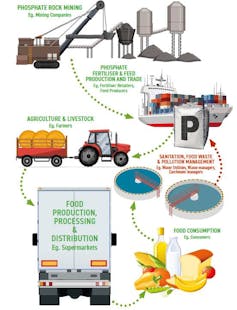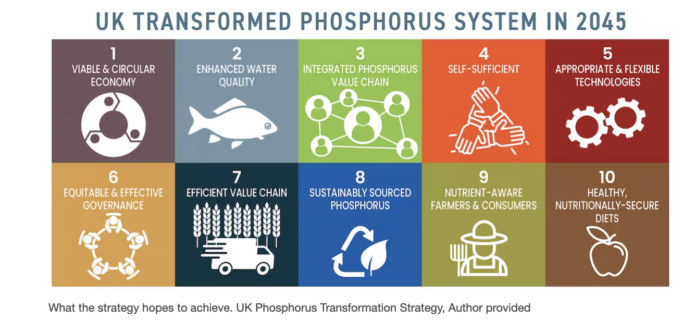Phosphorus supply is increasingly disrupted – we are sleepwalking into a global food crisis

By Julia Martin-Ortega, University of Leeds; Brent Jacobs, University of Technology Sydney, and Dana Cordell, University of Technology Sydney
Without phosphorus food cannot be produced, since all plants and animals need it to grow. Put simply: if there is no phosphorus, there is no life. As such, phosphorus-based fertilisers – it is the “P” in “NPK” fertiliser – have become critical to the global food system.
Most phosphorus comes from non-renewable phosphate rock and it cannot be synthesised artificially. All farmers therefore need access to it, but 85% of the world’s remaining high-grade phosphate rock is concentrated in just five countries (some of which are “geopolitically complex”): Morocco, China, Egypt, Algeria and South Africa.
Seventy per cent is found in Morocco alone. This makes the global food system extremely vulnerable to disruptions in the phosphorus supply that can lead to sudden price spikes. For example, in 2008 the price of phosphate fertilisers rocketed 800%.
At the same time, phosphorus use in food production is extremely inefficient, from mine to farm to fork. It runs off agricultural land into rivers and lakes, polluting water which in turn can kill fish and plants, and make water too toxic to drink.
In the UK alone, less than half of the 174,000 tonnes of imported phosphate are actually used productively to grow food, with similar phosphorus efficiencies measured throughout the EU. Consequently, the planetary boundaries (the Earth’s “safe space”) for the amount of phosphorus flow into water systems have long been transgressed.
Unless we fundamentally transform the way we use phosphorus, any supply disruption will cause a global food crisis since most countries are largely dependent on imported fertilisers. Using phosphorus in a smarter way, including using more recycled phosphorus, would also help already stressed rivers and lakes.
We are currently experiencing the third major phosphate fertiliser price spike in 50 years, thanks to the COVID-19 pandemic, China (the biggest exporter) imposing export tariffs, and Russia (one of top five producers) banning exports and then invading Ukraine. Since the start of the pandemic, fertiliser prices have risen steeply and at one point had quadrupled within two years. They are still at their highest levels since 2008.

Stop ignoring phosphorus
Despite its critical importance, there is no comprehensive global framework for phosphorus governance. It is largely ignored in international policy discussions, and in countries where phosphorus regulation does exist, it is often dated and fails to address food security.

Policies have generally focused on removing phosphorus from wastewater to prevent water pollution or encouraging farmers to fertilise fields with phosphorus-rich animal manure or to use less phosphorus in the first place. These are fine, but they are piecemeal and ignore important inefficiencies at other stages in the food supply chain, for example in producing fertiliser, or in food processing or arising from our dietary choices.
For more than a decade, scientists have been warning that if no one takes responsibility for ensuring phosphorus security, further disruptions in its supply can have major consequences for the food system. Vulnerable farmers could be pushed to the brink and global crop yields severely reduced. We are essentially sleepwalking into a food crisis.
The first comprehensive national strategy
But there is still time to wake up. We have put together the first ever UK National Phosphorus Transformation Strategy to help guide the country away from its current unsustainable situation. If the UK government and institutions were to adopt this strategy, we hope it could trigger a broader transformation elsewhere.

Surprisingly, despite being almost entirely dependent on imported phosphorus in fertilisers and animal feed, our team’s research shows the UK theoretically has enough phosphorus already circulating in the food system: 90,000 tonnes per year of “legacy phosphorus” accumulate in agricultural soils, 26,000 tonnes per year leak into water bodies and 22,000 tonnes are sent to landfill and construction. These hotspots of phosphorus inefficiency and loss represent a critical resource, which could instead be used productively.
The strategy identifies six phosphorus priority pathways that can turn that around, ranging from the development of innovative technologies to financial incentives for industry and engaging communities in the changes needed.
This includes things like supporting the roll-out of “biodigesters” to process bulky animal manures and food wastes into concentrated and nutrient-rich fertilisers that can be more cost-effectively transported across the country to crop production areas. Or harmonising national policies to incentivise both phosphorus removal to prevent pollution, and stimulate the productive reuse of phosphorus-rich wastes for farmers.
The good news is that some of these actions are already underway at a small scale. If they are scaled up and others are introduced and become part of mainstream operations, then the UK’s phosphorus system can become more resilient. For that to happen, we need the commitment of all sectors involved and we need to address the issues in an integrated and collaborative way.
Importantly, the strategy has been developed after extensive consultation with farmers, regulators, policy-makers, food producers, wastewater companies and environmental managers. This should give us the confidence that change is possible.![]()
Julia Martin-Ortega, Professor, Sustainability Research Insitute. Associate Director water@leeds, University of Leeds; Brent Jacobs, Research Director, Institute for Sustainable Futures, University of Technology Sydney, and Dana Cordell, Associate Professor, Institute for Sustainable Futures, University of Technology Sydney
This article is republished from The Conversation under a Creative Commons license. Read the original article.



